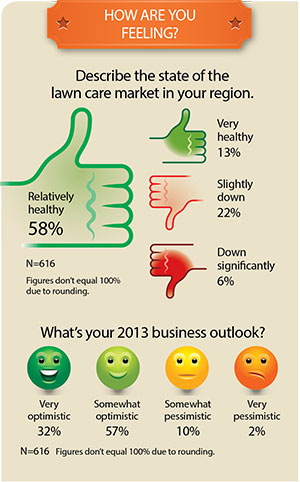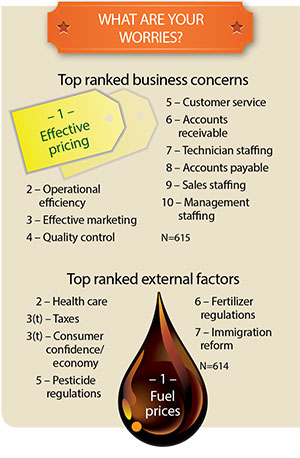Lawn care operators are positioned for a strong 2013.
Businesses operating on the lawn care side of the Green Industry are feeling positive about the year ahead.

Nearly 90 percent of respondents to Landscape Management’s Lawn Care Market Report survey say they are “very optimistic” or “somewhat optimistic” about their 2013 business outlook.
Companies say despite some less-than-stable conditions on the economic and political fronts, they’re positioned to grow this year. Only 8 percent expect a decrease in revenue for 2013 over 2012. Seventy-one percent expect an increase, and 21 percent foresee no change.
“The market is coming around a bit,” says Andrew Ziehler, president of Ziehler Lawn and Tree Care in Centerville, Ohio. His firm grew 40 percent last year and is expecting another 40 percent bump this year. “I think it’s going to be a good year. People are tired of doing without. For years they’ve tried to save money and they’ve lost out on service or quality.”
On the East Coast, Jim Campanella, owner of Lawn Dawg, a $10 million, 10-branch outfit based in Nashua, N.H., agrees.
“We’re projecting about 16.4 percent growth this year, and we think that’s a little conservative,” he says, noting the growth will be organic vs. through acquisitions. Lawn Dawg has acquired three firms since December 2011. “We’re already ahead of the same time last year.”
Bill Leuenberger, soil and turf management department manager for Chalet’s landscape division in north Chicago, Ill., also sees a good year on the horizon for lawn care.
“I think lawn care will continue to do fairly well,” he says. “People don’t go on vacations like they used to, they’re putting money into their yards and one of the cheapest ways to look good is through lawn care, maintenance and specialty gardens. Those three areas have been strong for us the past year and I believe that’s going to continue.”
Challenges Remain
Despite overall optimism, there are some concerns. For example, the 2 percent payroll tax reduction workers have benefited from the last two years expired on Jan. 1. That amounted to an annual pay cut of up to $2,202 for a worker earning $110,000 a year, the Wall Street Journal reports. When families have to tighten their budgets, some opt to cut discretionary expenses like lawn care, says Lee Kral, lawn service manager for Mountain High Tree, Lawn & Landscape Co., Lakewood, Colo. His division constitutes about 20 percent of the company’s $7 million in annual revenue. He plans for lawn care to be up about 5 percent in 2013 over 2012, but says that may be a struggle.
“Originally I thought 2013 was going to be good,” he says. “It’s not looking as good as I thought it would look. A lot of people are on the fence this year. In Colorado, there’s still a pretty high foreclosure rate, we’ve got a lot of older people and everyone recently saw the payroll tax hike take a bite out of their checks.”

Plus, Kral points to Washington, D.C., specifically the series of federal spending cuts that went into effect March 1 (better known as the sequester) as a major source of uncertainty that could hurt the economy.
These federal cuts are also a concern for Rick LaNore, technical director and co-owner of MRW Lawns in La Plata, Md. Last year was a good year for his firm, but when you ask him about 2013 he says, “That depends.”
“We’re looking at something different this year with the sequester,” he says. “We have a lot of customers in the military and government, and we’re getting some phone calls from folks getting furloughed, so we’re not sure how it’s going to affect us.”
Another concern for LCOs is complying with new restrictions and regulations, and that will be the case for LaNore later this year. Beginning in the fall, the state of Maryland’s new fertilizer law goes into effect, including a blackout period from March 1 through Dec. 1 when companies can’t apply fertilizer. Historically, LaNore’s company has started applications in mid-February.
Campanella has concerns about impending restrictions in several of the states in which he operates.
“The Northeast has some of the toughest regulatory controls on lawn care there are,” he says.
One thing he has his eye on is the Northeast Voluntary Turf Fertilizer Initiative, a collaborative of six states, the Environmental Protection Agency and other stakeholders that are looking to develop regional turf fertilizer application guidelines.
“There’s talk about reducing the amount of fertilizer per application, the amount allowed over the course of the year, phosphorous restrictions and reducing annual nitrogen input,” Campanella says. “We’re concerned about it—that it’s not based on any good science. We plan to attend the meetings and tell the decision makers that a healthy lawn is the best protection you can have against runoff.”
(For more on the restriction and regulatory landscape, see Bound by restrictions.)
Internal Focus
Despite challenges, most companies plan to focus internally to prosper this year.
Kelly Banfield, president and CEO of Banfield’s Lawn Care & Landscaping in Pace, Fla., takes a refreshingly simple approach to his business.
“To me, it seems pretty easy,” he says. “If you say you’re going to do something and follow through, I’ve never had a problem being in business.”
His 3-year-old business, 60 percent of which is made up of lawn care revenue, is on track to do $1.8 million in 2013. Before moving to the Florida panhandle and founding Banfield’s, he grew and sold a firm in Youngstown, Ohio, called Naturally Green.
He says, “If you have a good product and stand behind it, wherever you’re at, you’ll be successful.”
Likewise, Campanella attributes his company’s projected growth in recent years to internal measures, namely marketing campaigns, the centralization of its sales division and quality service.
“We’ve been able to grow the business significantly and keep a majority of our carryover customers,” he says.
LaNore, too, says quality is the key to retention, which in turn generates more business through referrals. He says his company’s cancellation rate is about 12 percent, compared to some national firms that can be as high as 40 percent annually. “In the fall we were able to increase referrals by 35 percent—we really weren’t asking for them before,” he says. “So now we’re focusing on referrals and on encouraging salespeople to create their own leads: knock on a few doors, do more block leading. We’ll probably get warmer leads and the closing percentage should go up.”
Ziehler is counting on a well-trained, happy staff to ensure success.

“This year we have a 100 percent return rate for our staff,” he says. “That’s huge. We’ve done a lot to develop our staff and make sure it’s a good place to work.”
How so? “It’s adding up a bunch of tiny things that make everyone’s day a bit easier,” Ziehler says. These measures include a complimentary healthy snack center at the office, free Gatorade for production members on Fridays during the summer and company-provided 2-gallon water jugs for employees during the season.
Additionally, once a month the whole company meets for a “Z Team Breakfast.”
“We take a few minutes to go over what’s happened in the previous month, share any compliments we’ve gotten, discuss things to look out for and talk about anything that needs to be improved,” Ziehler says, noting the meetings also often include games and prizes to make it fun. “Sometimes you get that divide between sales and the office and production, and this has really brought everybody together.”
What major pests are you combatting this year?
“The biggest thing is Emerald Ash Borer, but it’s been here for a while now. They’ve found Asian Longhorned Beetle in some parts of southern Ohio, but we haven’t dealt with it here. It’s quarantined, but you do still have to pay attention.” —ANDREW ZIEHLER, Ziehler Lawn and Tree Care/Centerville, Ohio
“Stink bugs, although they’re not supposed to be as bad this year. And the department of agriculture is going crazy about Emerald Ash Borer, but we haven’t seen a big problem here yet.” —RICK LANORE, MRW Lawns/La Plata, Md.
“Chinch bugs are always a big concern of ours, and we also deal with mole crickets and fire ants. Plus there are the insects there’s no cure for, like ground pearl and nematodes, to some degree.”—KELLY BANFIELD, Banfield’s Lawn Care & Landscaping/Pace, Fla.
“Last year we saw chinch bugs for the first time on the North Shore of Chicago. It’s hard to forecast if it’ll be a problem but we’re going to be proactive and try to get the insect at hatch before they actually do damage.” —BILL LEUENBERGER, Chalet/North Chicago, Ill.
“There’s nothing out of the ordinary, it’s grubs, chinch bugs and other nuisances such as weeds. And unfortunately, there’s a not a lot of new products for managing them. I’d like to see some new technology coming out of the chemical industry.”—JIM CAMPANELLA, Lawn Dawg/Nashua, N.H.

